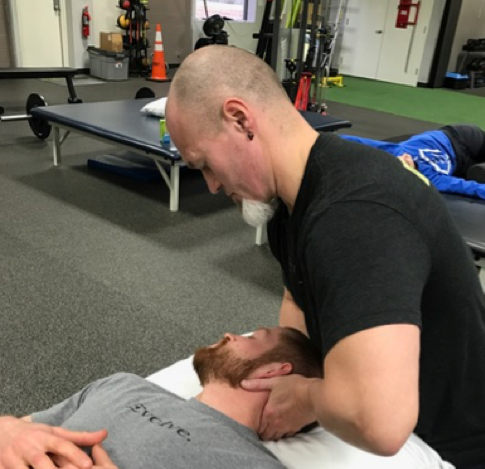Manipididoodads
The WHY behind Spinal Manipulation
If you have been to a Physical Therapist, Chiropractor, or Osteopath in
the past, you may be familiar with one of the common manual therapytechniques
utilized across all disciplines known as manipulations. Manipulations involve one
high-velocity, low-amplitude thrusting motion administered with the purpose of creating an analgesic (pain reducing/relieving) effect. Manipulations
can be performed on joints throughout the body, however most commonly they are
performed on the vertebrae of the spine to address cervical, thoracic, and/or
lumbar pain.
Clinicians regardless of profession treating similar orthopedic conditions should not use manipulations as the only form of treatment. They should rather use manipulations as one component of their treatment other interventions and with a combination with specific exercises to target a patient’s impairments. Multiple
studies have shown that patients reported similar improvements in symptom
reduction following either spinal manipulation or an exercise program. However,
patients reported the greatest improvement in symptom reduction when spinal
manipulations were combined with an exercise program.
Several studies have looked at the analgesic effects of spinal manipulations by analyzing pain pressure threshold values prior to and following a manipulation. Pain pressure thresholds (PPTs) are defined as the minimal amount of pressure required for patients to perceive as painful. Following spinal manipulations, patients have experienced increased pain pressure thresholds meaning their tolerance of a painful stimulus increased. Manipulations have been shown to not only have a local analgesic effect to the joint manipulated, but also an overall reduction in the body’s sensitivity to pain. This is due to the effects that manipulations have on central sensitization. Central sensitization is a neurological process of the body in which increased sensitization is correlated with chronic pain syndromes. Manipulations have been shown to have a reducing effect on central sensitization, therefore potentially being beneficial for patients presenting with chronic pain or chronic pain syndromes.
One aspect that anyone who has received a manipulation or observed a manipulation being performed probably has experienced is a “popping” sound known as a cavitation. The sound produced by a cavitation was previously thought to be a collapse of an air bubble within the joint, however evidence suggests this sound is not related to air bubbles but is due to a cavity formation in the joint when a manipulation is performed. Cavitations do not necessarily suggest that a manipulation has been effective or therapeutic, however they are widely considered a hallmark of a successful manipulation. Absence of cavitation also does not necessarily mean the manipulation did not have some therapeutic effect. Often with spinal manipulations it is common to hear multiple cavitations within one manipulative movement as multiple spinal levels can be targeted at once. Ultimately, cavitations are a very common part of manipulations and should not be considered a signal of damage or adverse outcome.
Much like any intervention implemented by a PT or other health professional, there are some contraindications to performing manipulations on patients that have a specific past medical history or previous pathology. Contraindications are reasons for not performing a specific intervention as it may lead to harm for the patient. Contraindications for spinal manipulations are as follows: malignancy/cancer in the area of manipulation, rheumatoid collagen necrosis, recent/unhealed fracture in the area of manipulation, ligament rupture or instability of joint being manipulated, metabolic bone disease, bony fusion or ankylosis of joint being manipulated, and osteomyelitis. If any of these conditions apply to you, be sure to inform your health professional prior to receiving a manipulation.
Manipulations are not the end all, be all; but they are an important part of a Orthopedic Manual Physical Therapy skillset, one the therapists at Evolution Sports Physiotherapy possess. Our therapists have had extensive training through a number of organizations including but not limited to MAPSand AAMTto develop an eclectic and thorough application of manual therapy. If you have not had successful treatment for neck and back conditions thus far or are curious as to whether or not these techniques may be appropriate for you, please feel free to contact us for an evaluation.
Resources:
1)Bialosky, Joel E., et al. “How Spinal Manipulative Therapy Works: Why Ask Why?” Journal of Orthopaedic & Sports Physical Therapy, vol. 38, no. 6, 2008, pp. 293–295., doi:10.2519/jospt.2008.0118.
2)Bialosky, Joel E., et al. “Spinal Manipulative Therapy–Specific Changes in Pain Sensitivity in Individuals With Low Back Pain (NCT01168999).” The Journal of Pain, vol. 15, no. 2, 2014, pp. 136–148., doi:10.1016/j.jpain.2013.10.005.
3)Coronado, Rogelio A., et al. “Changes in Pain Sensitivity Following Spinal Manipulation: A Systematic Review and Meta-Analysis.” Journal of Electromyography and Kinesiology, vol. 22, no. 5, 2012, pp. 752–767., doi:10.1016/j.jelekin.2011.12.013.
4)Dunning, James, et al. “Bilateral and Multiple Cavitation Sounds during Upper Cervical Thrust Manipulation.” BMC Musculoskeletal Disorders, vol. 14, no. 1, 2013, doi:10.1186/1471-2474-14-24.
5)Kawchuk, G., et al. “Visualization of Joint Cavitation in Realtime.” Physiotherapy, vol. 101, 2015, doi:10.1016/j.physio.2015.03.3595.
6)“United Kingdom Back Pain Exercise and Manipulation (UK BEAM) Randomised Trial: Effectiveness of Physical Treatments for Back Pain in Primary Care.” Bmj, vol. 329, no. 7479, 2004, p. 1377., doi:10.1136/bmj.38282.669225.ae.
7)Voogt, Lennard, et al. “Analgesic Effects of Manual Therapy in Patients with Musculoskeletal Pain: A Systematic Review.” Manual Therapy, vol. 20, no. 2, 2015, pp. 250–256., doi:10.1016/j.math.2014.09.001.












